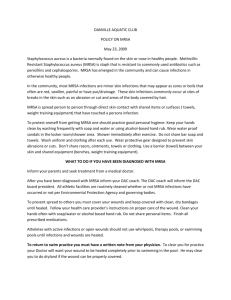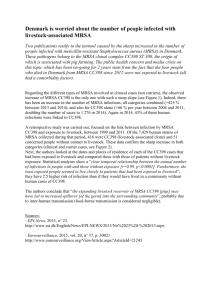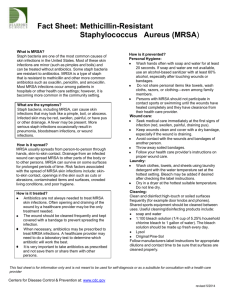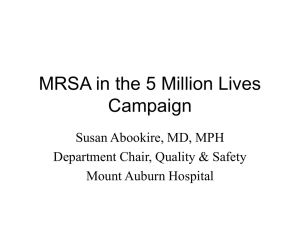DRAFT MRSA FAQS
advertisement
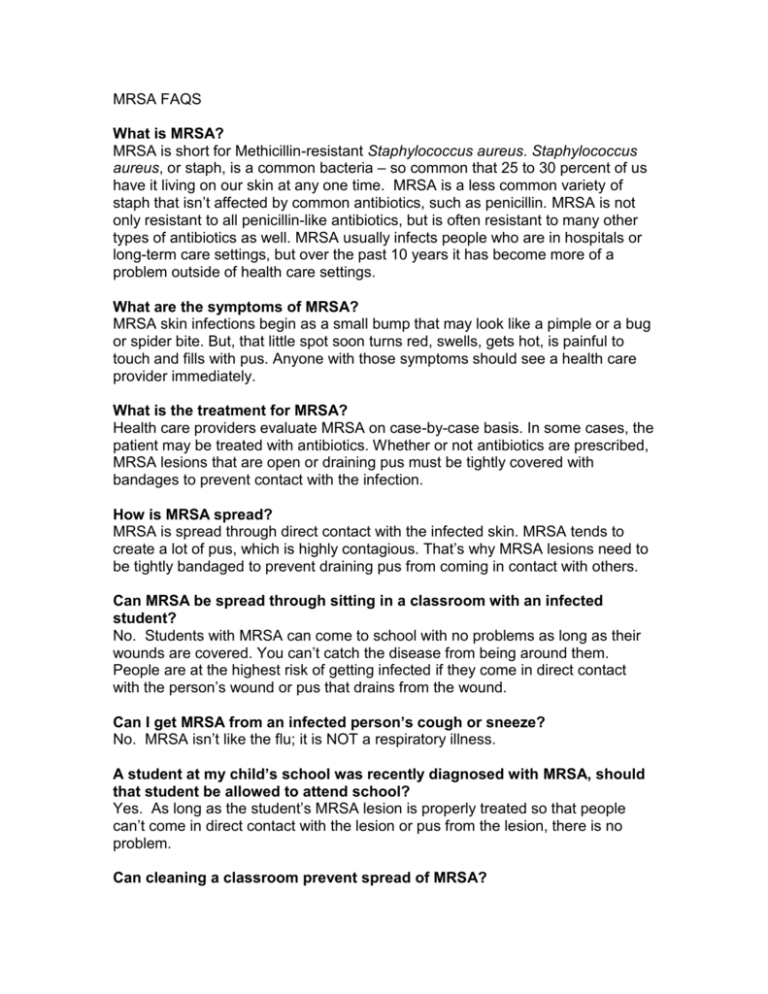
MRSA FAQS What is MRSA? MRSA is short for Methicillin-resistant Staphylococcus aureus. Staphylococcus aureus, or staph, is a common bacteria – so common that 25 to 30 percent of us have it living on our skin at any one time. MRSA is a less common variety of staph that isn’t affected by common antibiotics, such as penicillin. MRSA is not only resistant to all penicillin-like antibiotics, but is often resistant to many other types of antibiotics as well. MRSA usually infects people who are in hospitals or long-term care settings, but over the past 10 years it has become more of a problem outside of health care settings. What are the symptoms of MRSA? MRSA skin infections begin as a small bump that may look like a pimple or a bug or spider bite. But, that little spot soon turns red, swells, gets hot, is painful to touch and fills with pus. Anyone with those symptoms should see a health care provider immediately. What is the treatment for MRSA? Health care providers evaluate MRSA on case-by-case basis. In some cases, the patient may be treated with antibiotics. Whether or not antibiotics are prescribed, MRSA lesions that are open or draining pus must be tightly covered with bandages to prevent contact with the infection. How is MRSA spread? MRSA is spread through direct contact with the infected skin. MRSA tends to create a lot of pus, which is highly contagious. That’s why MRSA lesions need to be tightly bandaged to prevent draining pus from coming in contact with others. Can MRSA be spread through sitting in a classroom with an infected student? No. Students with MRSA can come to school with no problems as long as their wounds are covered. You can’t catch the disease from being around them. People are at the highest risk of getting infected if they come in direct contact with the person’s wound or pus that drains from the wound. Can I get MRSA from an infected person’s cough or sneeze? No. MRSA isn’t like the flu; it is NOT a respiratory illness. A student at my child’s school was recently diagnosed with MRSA, should that student be allowed to attend school? Yes. As long as the student’s MRSA lesion is properly treated so that people can’t come in direct contact with the lesion or pus from the lesion, there is no problem. Can cleaning a classroom prevent spread of MRSA? NO. Infection is not spread from floors or walls or from classroom items like desks, pencils, or water fountains, so cleaning a classroom isn’t the answer to reducing spread of MRSA. What actions can I take to reduce the spread of MRSA? The most important thing you can do to reduce the spread of MRSA and a lot of other infections like the flu and the common cold is to wash your hands thoroughly and often. Wash your hands with warm soapy water for a minimum of 15 seconds. If soap isn’t available, you can use alcohol-based hand sanitizers. It is always good practice to wash your hands after using equipment that others may have just used, like weights. If you come in contact with another person’s open wound, infected skin or soiled bandages, you should also wash your hands right away. Other personal hygiene actions like showering on a daily basis and wearing clean clothes can reduce the likelihood of MRSA infection. In school settings, what students are most likely to be infected? In North Carolina and the rest of the country, most outbreaks of MRSA in schools involve athletes participating in contact sports like football and wrestling. That’s because athletes are more likely to have broken skin, which gives the bacteria an easy way into the body. They are also likely to share personal items like towels in locker room situations or come in direct contact with other athletes who may have open or draining wounds on the playing field. That’s why it is particularly important that athletes and their coaches be on the lookout for MRSA symptoms and practice good hygiene when it comes to washing their hands and covering open wounds. Are there special actions that should be taken in athletic settings to reduce MRSA spread? Yes. Athletes should not share personal items such as towels. No one with open wounds or draining skin lesions should ever use whirlpools, ice tubs, saunas or hot tubs. Shower as quickly as possible after exercising, and always shower with soap before and after using whirlpools, ice tubs, saunas or hot tubs. Although general environmental cleaning in the school won’t reduce the spread of MRSA, there are some other things that you can do in locker rooms or gyms to reduce MRSA. Places that come in contact with bare skin, like mats or weight benches, should first be cleaned with soap and water and then disinfected with a disinfecting product after each use. Always allow for contact time or air drying per manufacturer’s instructions after using a disinfecting product on items. Weight equipment that comes in contact with skin should be cleaned daily, and everyone should wash their hands after using weight equipment. Use a clean towel as a barrier between bare skin and surfaces like weight benches. Get rid of equipment that is too damaged to clean. Wash towels and athletic clothes in hot water with ordinary detergent and dry on the hottest setting recommended for the fabric. Members of an athletic team at my child’s school were diagnosed with MRSA. The athletic team was told to take special precautions. My child is not a member of the team, and no special precautions were taken in his classroom, which includes some of the infected students. Why is there different advice for these two groups? Students in a classroom setting aren’t going to have direct contact with an infected student’s lesions. As long as a student’s wounds are properly bandaged, there is little likelihood of such contact. But, athletes have more direct contact with each other – either on the playing ground or in locker rooms. They are more likely to be infected as a result. How many cases of MRSA occur in North Carolina? Few states track the number of MRSA cases. That’s because the disease is a fairly common infection. States also don’t track numbers of other common infections like the flu. Rather than focusing on numbers, the focus should be on looking for, and treating, MRSA symptoms; another area of focus is personal hygiene – like hand washing – that can reduce spread of the disease.


